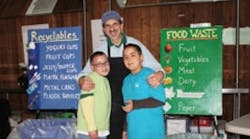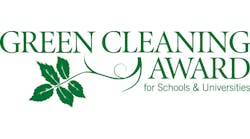Green Chimneys School always has been an environmentally concerned community. Beginning as a farm and summer camp more than 60 years ago, connection to the environment has been a cornerstone of its policies and procedures over the years. Working with animals as a way for emotionally injured children to open up, connect and heal, environmental stewardship remains a major component of Green Chimneys School’s therapeutic milieu.
Since the beginning, Green Chimneys has grown to almost 50,000 square feet of cleaning area. In 2007, Deb Stafford was appointed as housekeeping manager. She used her experience and knowledge to transform a traditional housekeeping department, where bleach and other chemicals were the basic cleaning arsenal, to a green cleaning initiative. With 200 students, most with emotional, learning and social challenges, keeping the school clean was a major challenge in itself.
The nature of the business and the building-specific cleaning requirements necessitated creating an effective green cleaning environment. Along with the expertise of cleaning consultant Greg Fiandra, Green Chimneys was able to reduce chemical usage by 75 percent.
The school consists of classrooms, restrooms, hallways, a dining hall, kitchen, gym, locker room and pool. It also includes a farm, horse barn and organic garden. By using a few green cleaners and closed-loop dilution systems, the school has implemented more efficient and safer cleaning procedures. Because of bulk purchasing, pricing remains competitive, and shipping costs are greatly reduced. The housekeeping supplies budget has decreased 17 percent over 3 years.
One major challenge is to “keep the dirt out,” and matting is the first line of defense. The campus has 30 buildings, including a farm, garden, pathways and unpaved roads. The school purchased 1161 square feet of matting, and reduced the waste stream by 4,644 plastic bottles. The mats use 100 percent P.E.T. from used plastic drinking bottles and 15 to 20 percent rubber reclaimed from used tires.
Using Green Seal and environmentally preferred products, the school achieves better cleaning, disinfecting and sanitization results. Disinfectant use is limited to high-touch areas such as door handles, keyboards, light switches and tables.
The use of hydrogen peroxide and natural enzymes is more effective and less hazardous to students, residents, employees and the surrounding wetlands. The bio agents eat grease naturally and other organic materials benefit the sensitive septic system. Additionally, the dispensing systems make daily cleaning chores less labor-intensive. As a not-for-profit organization, reducing the cleaning budget nearly 20 percent over the past three years is most impressive.
Green cleaning also requires a change in cleaning practices and equipment. The purchase of a floor scrubber machine with new technology cleans floors with water (No chemicals or detergents).
Additionally, the dining hall bathrooms were renovated and installed with photovoltaic sensor water faucets. Average daily water use by the laundry also was reduced by switching from solid detergent requiring dilution, to highly concentrated, environmentally preferred solution. These small changes made a big impact by reducing daily water usage averages by 32 percent.
Though the goals for green cleaning are all encompassing, the most influential include reducing toxic exposure, reducing pollution to the environment, increasing recycling, purchasing Green Seal and EPP, efficiencies, cost savings and increased awareness.
POLICIES OR PROCESSES USED TO ENCOURAGE AND INVOLVE OTHERS.
In an effort to communicate the new cleaning policies and recycling efforts to students, staff, board members and public, the school utilized its internal newsletter, The Bulletin; school morning announcements; all-campus meetings; an article in the Green Chimneys magazine; and the school informed the public during our large community events. As a result of these efforts, Green Chimneys improved visibility as a “green” organization in the community.
Training continues with respect to equipment safety and utilization efficiency, consultant training and hands-on practice. Custodians and janitors are vested in the outcomes of their work. Training helps them to be experts in the field. This has lessened resistance and improved morale while also improving the positive results the staff see on a daily basis. Because of the diversity within the Housekeeping Dept., procedures often use pictorials to simply explain necessary steps.
Innovations:
Composting, nature’s way of recycling
RECYCLING IN THE DINING HALL
Some things to know about the dining hall
Remember this, and you’ll know it all
The big blue bin is where to stick
Stuff made of metal and … plastic
All paper, food and drink cartons
Go in the round green food waste bins
While you are busy being green
Rubber gloves keep you healthy and clean
One more thing about this plan
Everything else in the garbage can
Innovative new cleaning machines greatly reduce both chemical and labor usage necessary to eliminate odors.
No-touch cleaning equipment is designed to remove the maximum amount of soil, bacteria and other biopollution.
The Green Chimneys housekeeping department also purchased an electrically converted water technology scrubber. It is environmentally superior, socially responsible and eliminates the environmental impact of producing, packaging, transporting, using, and disposing of traditional cleaning chemicals.
Story of innovation—Matting: One major challenge is to “keep the dirt out,” and matting is the first line of defense. The campus has 30 buildings, including a farm, garden, pathways and unpaved roads. The school purchased 1161 square feet of matting, reducing the waste stream by 4,644 plastic bottles. The mats use 100 percent P.E.T. from used plastic drinking bottles and 15 to 20 percent rubber reclaimed from used tires.
Program Information
Number of students: 194
Square footage maintained: 50,000
Number of full-time custodians: 17 Annual cleaning budget: $492,330 (includes salaries, supplies, equipment)
Green cleaning team members: Deb Stafford, Housekeeping Manager; Get Green Committee, Community Group

